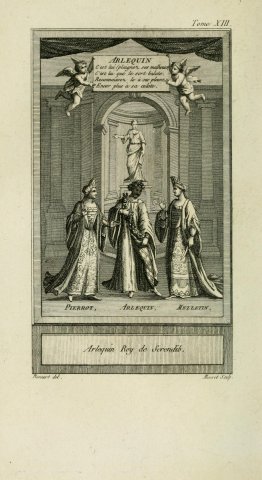Arlequin betrween Pierrot and Mezzetin (Lesage, Selected Works, 1810, vol. 13, Arlequin roi de Serendib) - Marillier
Notice précédente Notice n°24 sur 30 Notice suivante
Description
In the 1st scene, Harlequin, stranded on the island of Srendib, is shaken down by three brigands, who leave him prey to the wolves. Then Mezzetin, dressed as the priestess of the idol worshipped on the island, and Pierrot, as his confidante, appear.
They then explain the island's terrible custom:
Every month on the throne
A foreigner is placed;
But, heavens! to cut his throat!
When they arrived on the island, they disguised themselves as women to escape this custom. But the Grand Vizier has fallen in love with Mezzetin! He arrives to announce Harlequin's capture, and that he will marry Mezzetin...
The engraving illustrates the last scene of the play, where, with the month over, Mezzetin must sacrifice King Harlequin. But, determined to put an end to the custom, the false high priestess interrupts the ceremony. Mezzetin and Pierrot question Harlequin about his origins. He says he's from Bergamo, and they recognize him by his breeches:
Arlequin.
Air: M. la Palisse est mort, n°44.
It's him (pity his misfortunes),
It's him whom fate balots.
Recognize him by his cries,
Encor more by his breeches.
(He shows his Harlequin breeches)Mezzetin and Pierrot make themselves known in the same way.
- Signed below the engraving on the left "Bonnart del.", on the right "Macret Sculp."
Legend: "Arlequin Roy de Serendib. " - Farce in three acts performed in scrolls by the troupe of Baxter and Saurin, under the direction of the widow Baron, at the theater of the Foire Saint-Germain on February 3, 1713 and published in 1721 by Étienne Ganeau.
From January 2, 1709, actors at the Foire were forbidden to speak. Signs with verses were hung above the stage, allowing the audience to sing the lines, to tunes known at the time, played by musicians. This practice gave rise to comic opera. Lesage wrote seven écriteaux plays. - Gravure taken from Théâtre de la Foire, ou l'Opéra Comique by Le Sage and D'Orneval, Paris, Ganeau, 1724.
Technical Data
Notice #024876


